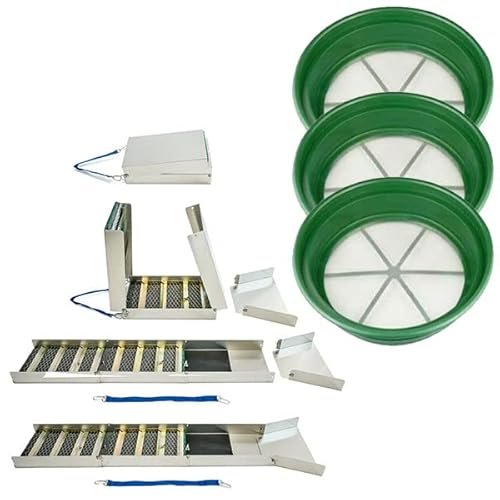Author: Superdom
Exquisite Craftsmanship: These 925 sterling silver pendant blanks includes 4 pieces of 6mm Round crown silver bezels for jewelry making findings. Our pendant trays for jewelry making has outstanding durability for jewelry projects.
Stand Out Perfection: Ideal for creating unique necklaces or costume jewelry, our pendant trays for jewelry making and silver bezels for jewelry making are expertly designed to accommodate gemstones and acrylic pieces, making your projects stand out.
Simple Assembly: Ideal for crafters, our silver bezel pendant trays or silver bezels for jewelry making are user-friendly. The 6mm Round cabochon blanks and sterling silver blanks ensure a perfect fit, enabling easy and swift jewelry creation.
Versatile Jewelry Making Kits: Our pendant trays for jewelry making is suitable for both beginners and pros, these bezels for jewelry making meet all your crafting needs. The durable pendant trays enhance your artistic creations.
Premium Jewelry Bezels: Crafted from 925 sterling silver bezel, our pendant blanks for jewelry making ensure a professional look. These bezel pendant trays are designed to be both beautiful and durable, providing lasting wear for your creations
Sluice Monkey 3 Pack of Large 1/2″, 1/4″, 1/8″ Mesh Screen Gold Panning Classifier. Fits on Top of 5-Gallon Bucket & Folding Aluminum Sluice Box – Extended 50″/Folded 15″
You are buying a 3-PACK of 1/8″ classifier sifting pan set You get a 3-PACK of 1/8″ MESH Classifiers, 1/8″, Features include: * Size: 11″ diameter bottom * Top diameter 13-1/4″ * 304 stainless steel wire * Fits into a 5-gallon bucket
The KN95 face mask is made of 2 non-woven outer layers, 2 melt-blown inner filter, 1 non-woven cotton middle layer, high efficiency to use.
The KN95 face mask offers more protection than a standard disposable 3-Ply mask. The filter efficiency is 95% greatly helps you.
These KN95 masks with a special triangular design that is built for quick and fast paced day-to-day activities.One size for women and men.
This KN95 face masks can be applied in home, office, school, park, playground, indoors, outdoors etc.
This KN95 mask is NOT an N95 mask. For more information about KN95 masks please see the following before you purchase: amazon.com/AboutKN95s.
Stay trendy with the Egg Hunting design of our Colored Eggs themed layout – definitely a conversation starter! Great for Egg Hunt fans, this Easter Sunday trend assures style & function.
The 10502500005 ways this Resurrection Sunday style can be enjoyed, will definitely make your Egg Basket shopping worth it! A lasting favorite, this Christian design will keep Bunnies enthusiasts coming back for more!
16” x 16” bag with two 14” long and 1” wide black cotton webbing strap handles.
Made of a lightweight, spun polyester canvas-like fabric.
All seams and stress points are double-stitched for durability, and the reinforced bottom flattens to fit more items and hold larger objects.
Spot clean/dry clean only.
ALL-IN-ONE WASHER AND DRYER- All-in-one washer and dryer combo with 1.62 cu.ft. (15 lbs) capacity.
PORTABILITY KIT – The portability kit includes 4 casters, Y connector & Faucet Adapter to connect to any faucet.
15 PROGRAMS – It offers 12 Wash cycles and three dry cycles including Heavy, Quite, Quick Wash, Sensor Dry, Time Dry, and more.
CONVERTIBLE DRYING – Easily switch drying mode from Vented (30% quicker) to Ventless or vice-versa.
CHILD LOCK – Secure child lock for added safety.
WINTERIZE CYCLE – The EZ 4600 winterizes in just 2 minutes: just simply add antifreeze and select its winterize mode.
PET CYCLE – Remove pet hair, dander, and fur with a dedicated Pet Cycle
SENSOR DRY – The sensor dry option gets your clothes perfectly dry, every time and prevents overdrying.
DRAWER – Organize your laundry room by storing supplies in the Pedestal.
2.5x 3.5x Magnification Professional Loupes, high quality optical glass material, can provide a large field of vision and deep viewing depth, small size and light weight, it is suitable for all kinds of medical dentists
Comfortable glasses frame or change to the interchangeable headband. Not only does it solve the fall problem effectively, but it also ensures a safer fit and reduces fatigue in the nasal bridge for prolonged use.
Adjustable Student Distance, After putting on the glasses, adjust the distance between the two lenses according to your own distance. Adjust the distance until the lens is focused, which can improve working efficiency
We are committed to making sure you love your purchase, so if for any reason you are not satisfied, contact us and we will provide you with a satisfactory solution.
Surgical loupes is very popular applied to , Neurological, Ophthalmology, Otorhinolaryngology, also can be used for Electronic and Industry.
FZTEY Great designed garden household gloves Which are made of high quality suede Cowhide leather.
These gloves are a practical choice for those tougher tasks, handling, gardening, Cycling driving protection, welding, flame cutting, gardening, mechanical operation work, Wood, Pruning, Yard, Farm, Building, Construction, brambles and nettlesetc.
Extra palm and forefinger provide protection with an extended loose safety cuff for forearm protection. These cut gloves have superior durability and flexibility because the seams are set away from the palm.Prevent burns, cuts, mechanical operation of gloves.
Carefully sourced compliant leather from our audited tannery Protection gloves use leather material, wear a hand is quite comfortable.not only thick and sturdy but soft and supple.
Gloves Size:9/Large ,Color:Green , Package Included : 1 Pair x Gloves











